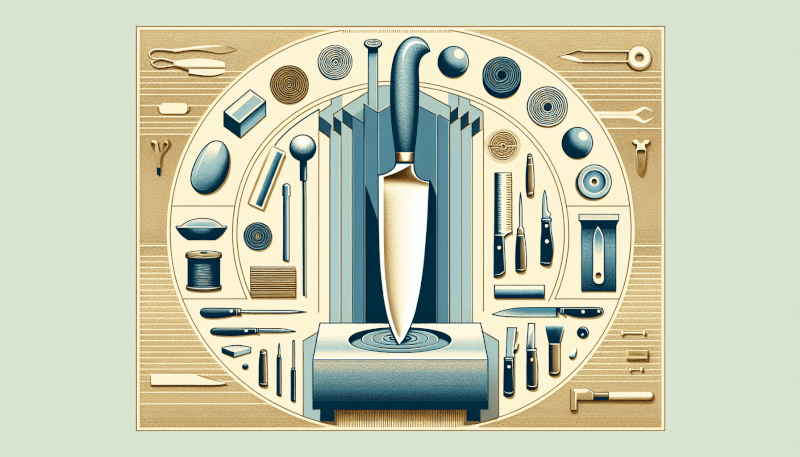If you’re a proud owner of a ceramic knife, you’re probably already aware of their exceptional cutting abilities. But like any sharp tool, a ceramic knife’s edge requires regular maintenance to stay at its best. In this article, we’ll explore some simple yet effective techniques to help you maintain the edge of your ceramic knife, ensuring it stays razor-sharp for years to come.

Understanding Ceramic Knives
Ceramic knives are a type of kitchen knife made from ceramic material, typically zirconium dioxide (Zirconia). This material is exceptionally hard, which allows ceramic knives to be incredibly sharp and maintain their edge for a long time. Unlike traditional steel knives, ceramic knives are also non-reactive, meaning they won’t transfer any metallic taste or odor to foods.
Advantages of Ceramic Knives
There are several advantages to using ceramic knives. Firstly, their sharpness is unparalleled. Ceramic blades are so sharp that they can effortlessly slice through fruits, vegetables, and boneless meat. This precision cuts down your prep time and allows for more accurate cutting. Additionally, the sharpness of ceramic knives means they require less force to use, reducing the risk of accidents or fatigue.
Another advantage of ceramic knives is their durability. While they may seem fragile due to their lightweight and thin design, ceramic blades are actually very resistant to wear and tear. They are highly resistant to staining and rusting, making them more hygienic and easy to clean. Unlike steel knives, ceramic blades also won’t corrode or react with acidic or alkaline foods.
Importance of Maintaining the Edge
To fully enjoy the benefits of ceramic knives, it’s crucial to maintain their sharp edge. Over time, the blade may dull and lose its cutting power. Proper maintenance ensures that your knife continues to perform at its best, prolonging its lifespan. Regular upkeep also helps prevent accidents since a dull blade requires more force to cut, increasing the chances of slips and uneven cuts.
Proper Handling and Storage
Proper handling and storage are essential for preserving the edge and integrity of your ceramic knife.
Using a Cutting Board
When using a ceramic knife, always opt for a cutting board made of softer materials such as wood, bamboo, or plastic. Hard surfaces like glass, granite, or ceramic can chip or damage the blade. Cutting boards made of softer materials also help reduce the impact on the blade, preserving its sharpness for longer.
Avoiding Hard Surfaces
To prevent accidental damage, avoid cutting or chopping directly on hard surfaces such as countertops, plates, or bowls. Even a slight slip can cause chips or cracks in the blade. Always use your ceramic knife on a suitable cutting board or mat.
Appropriate Storage
Proper storage is crucial to prevent unnecessary damage to your ceramic knife. Avoid storing it loose in a drawer with other utensils that can potentially hit or scratch the blade. Instead, consider using a knife block with individual slots, a blade guard, or a knife holder designed specifically for ceramic knives. These storage options will protect the blade from accidental contact and maintain its sharpness.
Cleaning and Drying
Cleaning and drying your ceramic knife correctly is essential for maintaining its performance and preventing damage.
Handwashing vs. Dishwasher
It is always recommended to handwash your ceramic knife. While some manufacturers claim their knives are dishwasher safe, the high heat and strong detergents used in dishwashers can be harsh on the blade. The sudden temperature changes and the potential for the knife to come into contact with other utensils can result in chips or cracks. Clean your ceramic knife with mild dish soap, warm water, and a soft sponge, and rinse thoroughly.
Avoiding Abrasive Cleaners
Abrasive cleaners, scouring pads, or harsh chemicals should never be used on ceramic knives. These can scratch or dull the blade, compromising its performance and longevity. Stick to gentle dish soap and avoid any abrasive substances that may damage the surface of the blade.
Drying After Cleaning
After cleaning, make sure to dry your ceramic knife thoroughly. Ceramic is more prone to staining and water spots, so it’s best to hand-dry the blade immediately using a soft cloth or towel. Avoid leaving the knife to air dry, as this can increase the risk of water spots or moisture-related damage.
Sharpening Techniques
While ceramic knives are known for their long-lasting sharpness, there may come a time when they require sharpening.
When to Sharpen
It’s essential to be aware of when your ceramic knife needs sharpening. Signs of a dull blade include increased resistance when cutting, tearing or squishing of food, or a noticeable decrease in cutting performance. If you’re experiencing any of these issues, it’s time to sharpen your knife.
Using a Ceramic Honing Rod
When your ceramic knife is slightly dull but doesn’t require a full sharpening, a ceramic honing rod can be used to restore its edge. To use the honing rod, hold it vertically and run the blade of the knife gently against it at a 20-degree angle, alternating sides. This process helps to realign the microscopic teeth along the edge of the blade, enhancing its sharpness.
Using a Whetstone
If your ceramic knife is significantly dull and needs a more aggressive sharpening, a whetstone is the ideal tool. Soak the whetstone in water for about 10 minutes, then place it on a stable surface. Hold the knife at a 20-degree angle and move it against the whetstone in a sweeping motion, starting from the base of the blade and moving towards the tip. Repeat this process on both sides of the blade until the desired sharpness is achieved.
Seeking Professional Sharpening
If you’re not confident in sharpening the ceramic knife yourself or don’t have the necessary tools, it’s best to seek professional sharpening services. Professionals can ensure your knife is sharpened correctly without the risk of causing further damage. They have the expertise and specialized equipment to restore your ceramic knife’s edge to its original sharpness.

Tips for Safe Usage
Using a ceramic knife safely is crucial to prevent accidents and maintain its longevity.
Avoid Excessive Force
Ceramic knives are incredibly sharp and require minimal force during cutting. Avoid applying excessive force, as this can increase the risk of slips or uneven cuts. The unparalleled sharpness of ceramic knives means they can slice effortlessly through foods with just a gentle motion.
Use Appropriate Cutting Techniques
When using a ceramic knife, practice proper cutting techniques. Use a gentle rocking motion or a vertical chopping motion to cut through fruits, vegetables, and boneless meats. Avoid using a sawing motion or applying lateral pressure, as this can cause the blade to chip.
Avoid Twisting or Bending the Blade
Ceramic knives are not flexible like their steel counterparts. Avoid twisting or bending the blade, as ceramic blades are more prone to breakage under stress. Always cut with a straight motion to maintain the integrity of the blade.
Preventing Damage
To prevent unnecessary damage to your ceramic knife, it’s essential to be aware of potential situations that can cause harm.
Avoid Cutting Frozen Food
While ceramic knives are excellent for slicing through fresh produce, they are not suitable for cutting through frozen foods or bones. The extreme cold and hardness of frozen items can cause the blade to chip or break. Instead, use a dedicated knife for frozen food and bone-related tasks.
Beware of Bones and Hard Pits
When preparing certain fruits or working with bone-in meats, exercise caution to avoid coming into contact with bones or hard pits. Ceramic knives are more susceptible to chipping or breaking when cutting through hard objects. It’s advisable to use a different knife or a serrated blade for tasks involving bones or hard pits.
Do Not Use as a Prying Tool
Ceramic knives should never be used as a prying or twisting tool. They are not designed to handle excessive force or torque. Using a ceramic knife for tasks beyond its intended purpose can lead to blade damage or even injury. Always use the appropriate tools for prying or twisting tasks.

Additional Care Recommendations
In addition to proper handling and cleaning, the following care recommendations can help keep your ceramic knife in optimal condition.
Using a Knife Guard
When storing or transporting your ceramic knife, consider using a knife guard or sheath. A knife guard provides an additional layer of protection, preventing accidental contact and reducing the risk of chipping or scratching the blade. Many ceramic knives come with a custom-fit guard for safe storage.
Regular Inspection for Chips or Cracks
Regularly inspect your ceramic knife for any signs of chips or cracks. Even the tiniest chip can compromise the integrity of the blade and potentially cause injury. If you notice any damage, it’s advisable to address it promptly to prevent further issues.
Avoid Extreme Temperature Changes
Ceramic knives are sensitive to sudden temperature changes. Avoid exposing your knife to extreme heat or cold as it can cause the blade to expand or contract abruptly, leading to cracks or fractures. It’s best to let your ceramic knife gradually acclimate to room temperature before use after being exposed to extreme conditions.
Handling Chips or Nicks
If your ceramic knife develops a chip or nick, it’s important to address it to prevent further damage.
Identifying and Addressing Chips
Inspect the blade of your ceramic knife carefully to identify any chips or nicks. If the chip is minor and doesn’t affect the overall performance, you can gently file it down with a fine-grit diamond file. However, if the chip is severe or impacts the cutting edge, it’s advisable to seek professional repair or consider replacing the knife.
Using a Diamond File
For minor chips or nicks, a diamond file with a fine grit can be used to smooth out the affected area. Gently run the file over the chip, working in one direction only. Be cautious not to file too aggressively, as this can change the angle of the blade and affect its cutting performance.
Professional Repair Options
If your ceramic knife has a significant chip or the damage affects the cutting edge, it’s best to consult a professional knife repair service. They have the expertise and specialized tools needed to repair ceramic blades safely and effectively. Professional repairs can restore your knife to its original condition and ensure its longevity.

Long-Term Maintenance
Proper long-term maintenance of your ceramic knife will help it stay in optimal condition for years to come.
Maintaining a Honed Edge
To maintain the sharpness of your ceramic knife’s edge, regular honing is recommended. Use a ceramic honing rod at a 20-degree angle, running the blade across it gently. Honing the blade realigns the teeth and ensures the edge remains sharp for longer periods between sharpening.
Proper Storage When Not in Use
When your ceramic knife is not in use, it’s important to store it properly. Keep it in a knife block, a knife holder, or a sheath specifically designed for ceramic knives, ensuring that the blade is protected and does not come into contact with other utensils. Avoid storing the knife loosely in a drawer where it can get damaged by other utensils or accidental knocks.
Periodic Professional Sharpening
While regular honing helps maintain the edge of your ceramic knife, periodic professional sharpening is still necessary. Professional sharpening services have the expertise and equipment required to restore the blade’s optimal sharpness. It’s recommended to have your ceramic knife professionally sharpened every 6 to 12 months, depending on usage.
Replacing a Ceramic Knife
Despite your best efforts to maintain and care for your ceramic knife, there may come a time when replacement becomes necessary.
Signs of Irreparable Damage
If your ceramic knife has sustained significant damage, such as a large, deep chip or a crack running through the blade, it may be irreparable. Such damage compromises the structural integrity of the knife and makes it unsafe to use. Additionally, if the blade has become significantly worn, thin, or unevenly sharpened, it may also be time for a replacement.
When to Consider Replacement
Consider replacing your ceramic knife if the damage cannot be repaired or if it impacts the knife’s performance. If you find that your sharpening efforts no longer restore the desired sharpness or if the blade consistently chips or cracks despite proper use and maintenance, it may be more cost-effective and safer to invest in a new knife.
Evaluating Cost-Effectiveness
Lastly, evaluate the cost-effectiveness of repairing versus replacing your ceramic knife. Repairing a severely damaged knife can be costly, especially if professional services are required. In some cases, purchasing a new knife may be more cost-effective, as it ensures you have a blade with a longer lifespan and optimal performance. Consider the extent of the damage, the age of the knife, and the overall cost of repairs when deciding whether to replace or repair your ceramic knife.
By following these guidelines for understanding, handling, cleaning, sharpening, and caring for your ceramic knives, you can ensure their longevity, retain their sharpness, and enjoy the precision they offer in your kitchen for years to come. Remember, proper maintenance is key to keeping your ceramic knives in optimal condition and ensuring safe and efficient food preparation.



